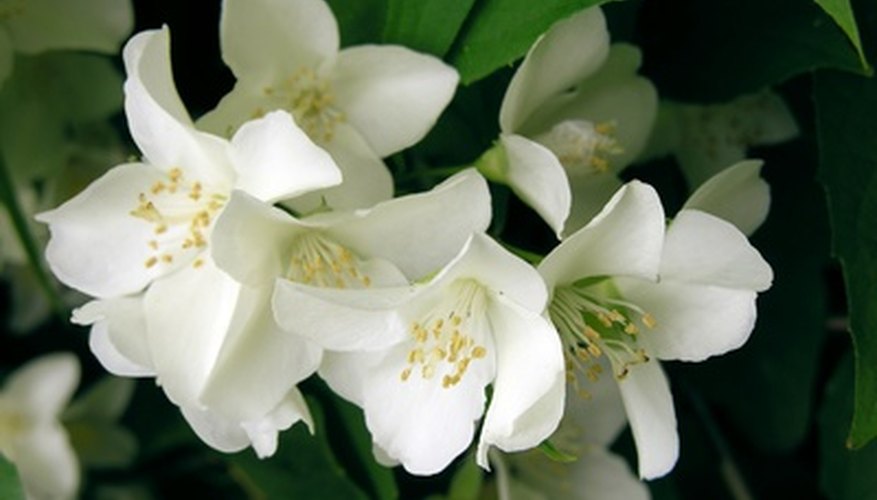Though jasmine plants are beloved to the home garden for their sweet, intoxicating scent, visual appeal and reputation as problem-free plants, they do not always live up to that reputation. If you notice that your jasmine's leaves are yellowing, take immediate action. Revise any accidental shortcomings in maintenance and examine plants to diagnose the problem to prevent further damage.
Preventive care
Identify the particular type of jasmine plant you are growing in your garden as certain care requirements vary from species to species. Provide consistent care to your jasmine plants as healthy, well-maintained jasmine has a better chance at avoiding problems than a weakened plant. Grow all jasmine in locations that offer full sun to partial shade for best growth. Cultivate this flowering vine or shrub in moist, well-drained soil. As jasmine plants prefer warm weather, keep them out of the cold. Semi-tropical vines like Spanish jasmine, for example, need night temperatures that remain above 10 degrees Celsius/50 degrees Fahrenheit. Contact your local county extension agent for assistance in selecting jasmine appropriate for your hardiness zone.
- Identify the particular type of jasmine plant you are growing in your garden as certain care requirements vary from species to species.
- As jasmine plants prefer warm weather, keep them out of the cold.
Problems
When it comes to the yellowing of otherwise attractive green foliage, the list of culprits is short. Improper maintenance is one of the main issues. Confederate jasmine, Trachelospermum jasminoides, is an aromatic jasmine species that needs fertilisation. Inadequate fertility results in leaves that take on a yellowed appearance. For all jasmine plants, if you notice yellow leaves, examine your plants closely for scale infestations. Soft scales like black scales are common pests to jasmine and other host plants like poplars, oleanders and cottonwood. Look for bumps on leaves and twigs. Scales display small, smooth bodies measuring 6.35mm / 1/4 inch in length. Black scales are known to inundate plants, so do not be surprised to find them all over your jasmine. Scale pests are sucking bugs that feed on plant tissue fluid.
- When it comes to the yellowing of otherwise attractive green foliage, the list of culprits is short.
- Soft scales like black scales are common pests to jasmine and other host plants like poplars, oleanders and cottonwood.
Damage
Improper fertilisation and soil conditions will likely not kill your plant, but the yellowing of leaves is an indication that something is amiss. Pests, however, can cause significant injury. As soft scales feed on plant tissue, they excrete a sticky-sweet substance called honeydew that drips onto plant parts. While the feeding alone diminishes overall plant health, the honeydew attracts ants and bees and encourages the growth of sooty mould. A black hued fungus, sooty mould can cover a jasmine plant, inhibiting sunlight absorption. Inadequate sunlight leads to severe decline or plant death.
- Improper fertilisation and soil conditions will likely not kill your plant, but the yellowing of leaves is an indication that something is amiss.
- While the feeding alone diminishes overall plant health, the honeydew attracts ants and bees and encourages the growth of sooty mould.
Solution
To improve your soil, bring a sample to your local county extension office for testing and make any suggested amendments. Fertilise confederate jasmine with a 12-4-6 fertiliser, recommends the Alabama Cooperative Extension System. Apply fertiliser in the beginning of spring and the middle of summer. For soft scale control, prune away and destroy severely affected plant parts. To control an extreme problem without removing most of your plant, spray insecticidal soap on the jasmine plant as this is a low-toxicity method of suffocating the pests without causing chemical damage.
- To improve your soil, bring a sample to your local county extension office for testing and make any suggested amendments.
